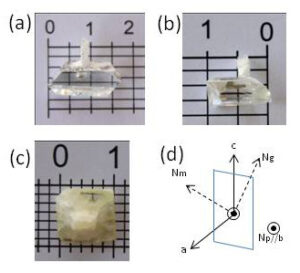 Modelocked femtosecond lasers require of luminescent ions with large emission bandwidth and tunability. This requirement is difficult to fulfill with lanthanides due to the inner nature of the 4f orbital. The concept of «disordered single crystals» which is based on multiple (isovalent or heterovalent) cationic substitutions on the same lattice site has gained attention to solve the problem but results are still limited. In our recent publication in Journal of Alloys and Compounds 961 (2023) 171092 (doi 10.1016/j.jallcom.2023.171092) we show that the random orientation of the Bi3+ non-bonded 6s2 lone pair induces a large band broadening of the Yb3+ emission in monoclinic KY1-x-yBixYby(WO4)2 single crystals. The growth of these crystals and their laser capabilities are demonstrated within the activity of our THINLAS project.
Modelocked femtosecond lasers require of luminescent ions with large emission bandwidth and tunability. This requirement is difficult to fulfill with lanthanides due to the inner nature of the 4f orbital. The concept of «disordered single crystals» which is based on multiple (isovalent or heterovalent) cationic substitutions on the same lattice site has gained attention to solve the problem but results are still limited. In our recent publication in Journal of Alloys and Compounds 961 (2023) 171092 (doi 10.1016/j.jallcom.2023.171092) we show that the random orientation of the Bi3+ non-bonded 6s2 lone pair induces a large band broadening of the Yb3+ emission in monoclinic KY1-x-yBixYby(WO4)2 single crystals. The growth of these crystals and their laser capabilities are demonstrated within the activity of our THINLAS project.
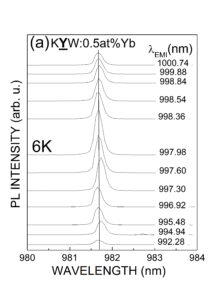
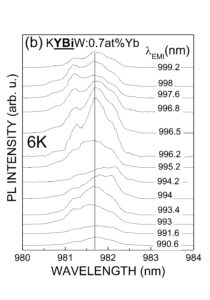

Most common thermometric luminescent nanoprobres contain alkaline and/or halogen ions which poisson currently used catalysts, for instance the well known NaYF4 host based compounds. Our IMPETUSS project (PID2021-128090OB-C21) aims the development of eficient luminescence nanoprobes compatible with standardly catalyzed reactions. In this direction we develloped alkaline and halogen-free β´Gd2(MoO4)2 nanoprobes doped with Yb3+, Er3+ and Tm3+. We defined three different ratiometric channels to determine temperature from 20 to 600ºC with optimised sensitivity. See Journal of Alloys and Compounds 913 (2022) 165180 doi 10.1016/j.jallcom.2022.165180.
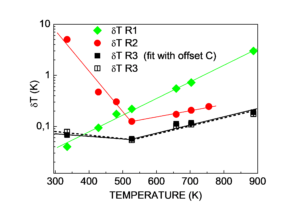

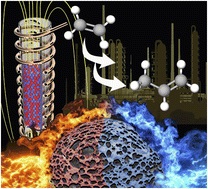 Our recent publication in Journal of Materials Chemistry A 2023, 11, 19854 (doi 10.1039/d3ta03654e) in collaboration with the Institute of Chemical Technology (UPV-CSIC) in Valencia (among others) adresses the problem found in Tandem Catalysis of having»spatially proximate but thermally distant» catalysts contained in a single reactor. An elegant solution arose through the specific heating of the hot catalyst by magnetic susception. A thermal gradient of 50 ºC between the hot and cold catalysts was infered by luminescence lifetime thermometry by using Eu3+-doped and Cr3+-doped nanoprobes. A probe of concept was demostrated by direct production of propene from ethene, via sequential olefin dimerization and metathesis reactions.
Our recent publication in Journal of Materials Chemistry A 2023, 11, 19854 (doi 10.1039/d3ta03654e) in collaboration with the Institute of Chemical Technology (UPV-CSIC) in Valencia (among others) adresses the problem found in Tandem Catalysis of having»spatially proximate but thermally distant» catalysts contained in a single reactor. An elegant solution arose through the specific heating of the hot catalyst by magnetic susception. A thermal gradient of 50 ºC between the hot and cold catalysts was infered by luminescence lifetime thermometry by using Eu3+-doped and Cr3+-doped nanoprobes. A probe of concept was demostrated by direct production of propene from ethene, via sequential olefin dimerization and metathesis reactions.

In February 2024 Dr. Xiumei Han incorporated to the REALM group as responsible of the Top Seeded Solution Crystal Growth laboratory.
Also in February 2024 Illán Calvo Llorente incorporated to the REAL group hired by THINLAS project.
We wish both of you all success during your stays.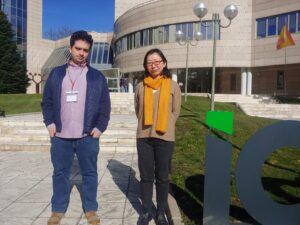
On July 14th 2021 Jorge Omar Álvarez Pérez obtained his PhD degree from the Autonomous University of Madrid with the work entitled «Caracterización física y láser de monocristales de granates desordenados tipo Ca3(NbGa)5O12 dopados con Yb3+» (Physical and laser characterization of Ca3(NbGa)5O12 disordered single crystals doped with Yb3+). The work was awared with the «cum laude» maximum qualificatlon.
The work “A roadmap for laser optimization of Yb:Ca3(NbGa)5O12–CNGG–type single crystal garnet” published in Journal of Materials Chemistry C vol 9, pgs 4628-4642, 2021 https://pubs.rsc.org/en/Content/ArticleLanding/2021/TC/D0TC05718E#!divAbstract
completes a trilogy of new physical knowledge and laser performance progress of this disordered cubic crystal garnet with applications in ultrashort laser pulse oscillators.
Following the path of our original proposal of CNGG Na+ modification for charge compensation of Yb3+ doping, in a first work we introduced a crystallographic model to describe the Yb3+ optical bandwidth. In a second work we disclosed the presence of a small amount of Yb3+ in centrosymmetric octahedral position with dominant magnetic dipole transitions. In the present work we describe how to minimize the crystal coloration, the limits for Na incorporation and the relevant parameters helping for laser performance optimization.
Na and Li codoping of Yb:CNGG is found to provide the broadest tuning range along with best laser preformances.
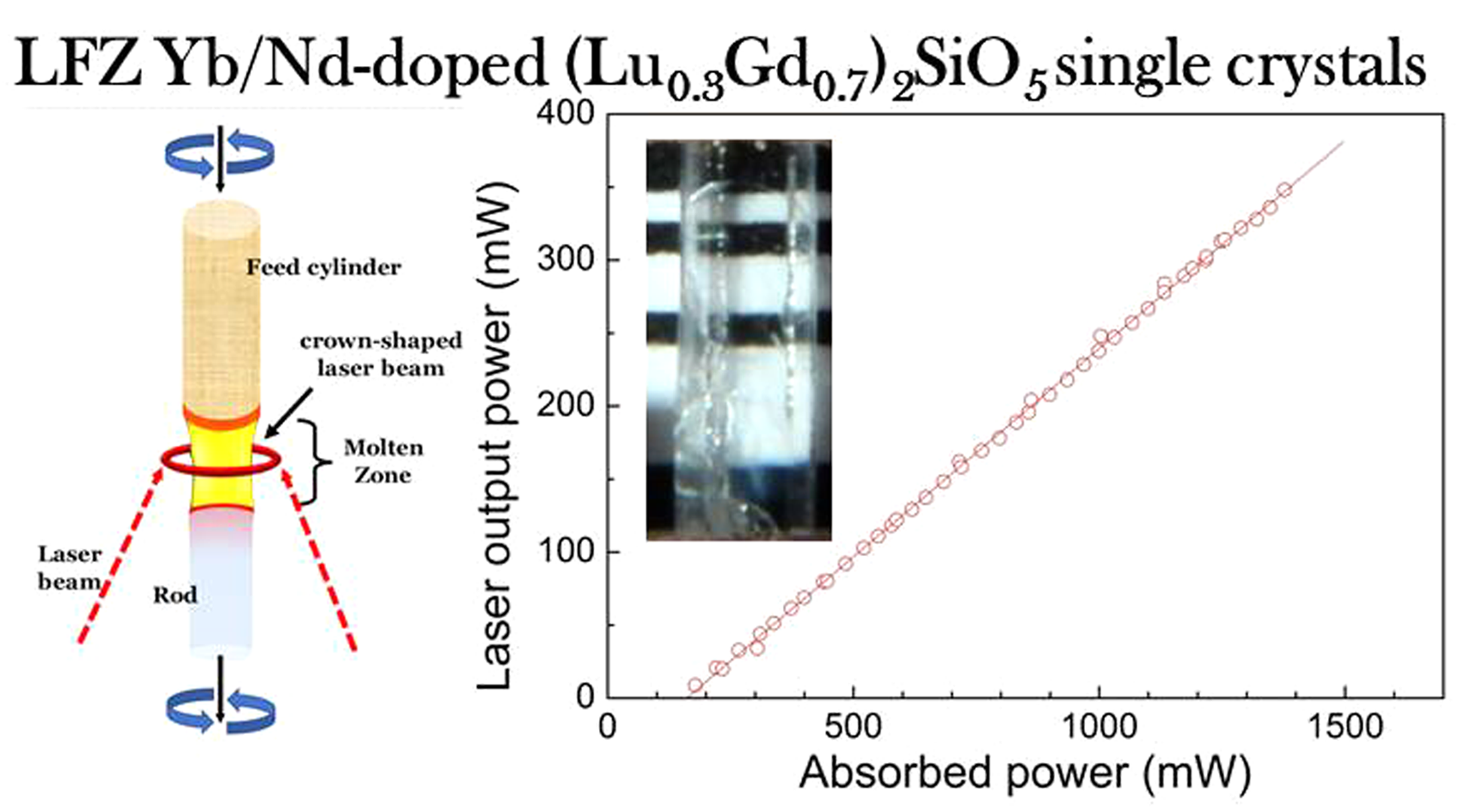 In a recent work published in Journal of Materials Chemistry C 8, 2065, 2020 https://pubs.rsc.org/en/content/articlelanding/2020/tc/c9tc05910e#!divAbstract we show that a laser material with relatively low thermal conductivity can be grown with laser quality by the Laser Floating Zone growth technique using a CO2 laser as heat source for material melting.
In a recent work published in Journal of Materials Chemistry C 8, 2065, 2020 https://pubs.rsc.org/en/content/articlelanding/2020/tc/c9tc05910e#!divAbstract we show that a laser material with relatively low thermal conductivity can be grown with laser quality by the Laser Floating Zone growth technique using a CO2 laser as heat source for material melting.
K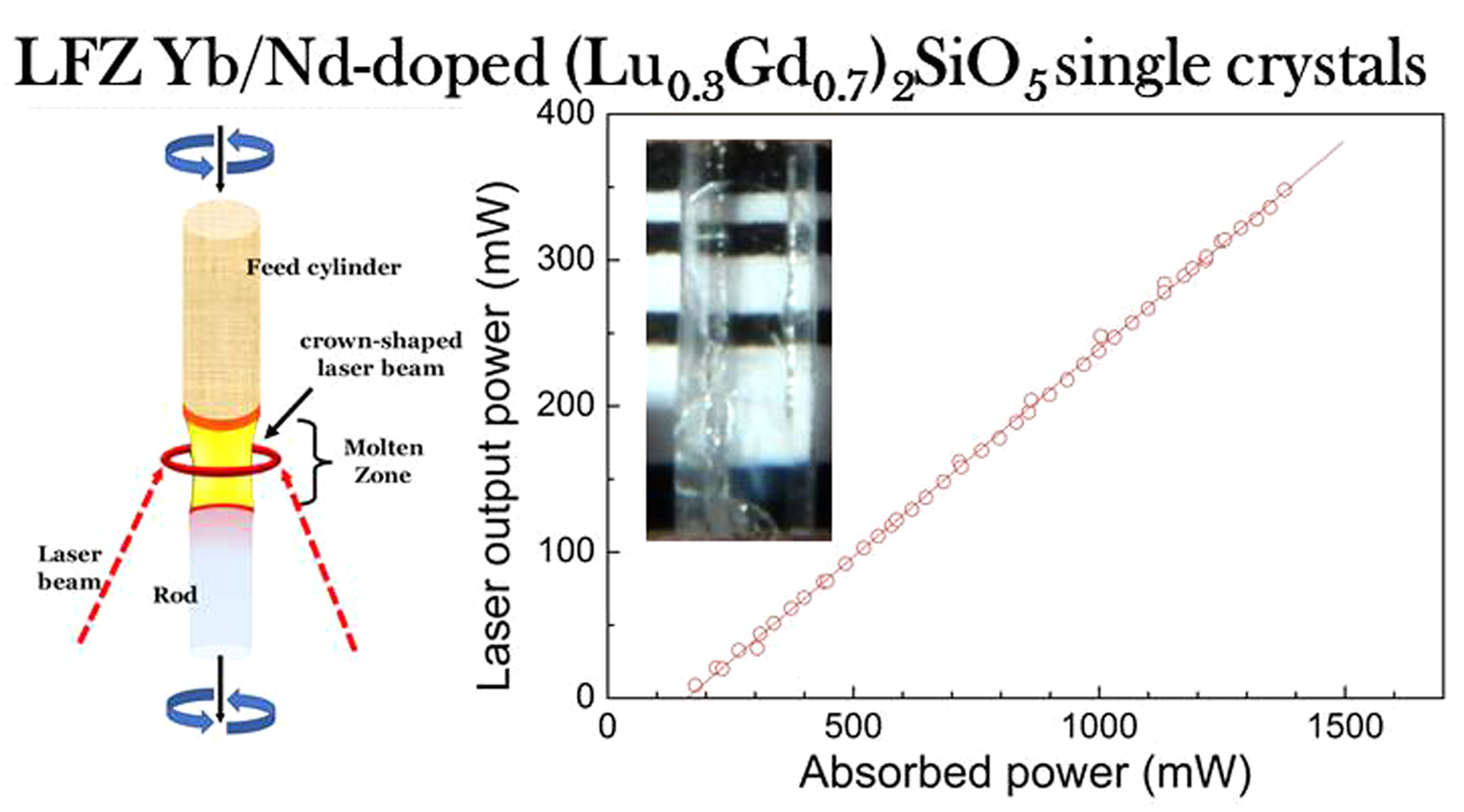 ey steps for this achievement have been the selection of the (Lu0.3Gd0.7)2SiO5 composition to obtain single phase material upon resolidification and the engineering of the heating/cooling cycles.
ey steps for this achievement have been the selection of the (Lu0.3Gd0.7)2SiO5 composition to obtain single phase material upon resolidification and the engineering of the heating/cooling cycles.
The lack of any crucible to hold the material allows the melting of refractory compounds above 1500 ºC in oxidizing atmospheres. This suposses a great advantage for the devellopment of crystals for mode-locked laser producing ultrashort laser pulses.
This has been possible through the collaboration with the Aveiro University.

«Alternative luminescent excitation and material processing paths for brightness and stability optimization of near infrared nanoprobes with biophotonic applications» project has been recently awarded for the period 2019-2021, including economic support of a doctoral position.
Personnel of Pharmacy Faculty of Complutense University-Madrid, Iberian International Nanotechnology Laboratory-Braga, Center of Ultrafast & Ultraintense Pulsed Lasers-Salamanca, and Aveiro University play several different roles in the project activity.
The project aims the development of new luminescent and magnetic nanoprobes and their excitation with commercially available and specifically developed ultrashort (fs) laser pulses and magnetic fields.
«Lanthanide-based luminescence thermosensors: From bulk to nanoscale«, https://doi.org/10.1016/B978-0-12-813840-3.00010-7 , Chapter 10 in the book entitled «Lanthanide-based multifunctional materials. From OLEDs to SIMs» has been published by ELSEVIER and authored by REALM.
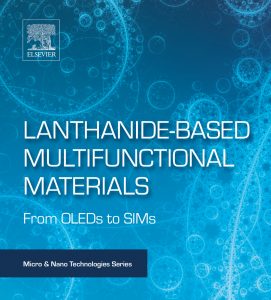
The COST Action CM1403 “The European Upconversion Network: From the Design of Photon-upconverting nanomaterials to Biomedical Applications” was established to support research networks, training of young scientists as well as scientific conferences in countries of the European Union.
More information is available on internet: www.cost.eu/COST_Actions/cmst/CM1403.
REALM group participates in the forthcoming UPCON18 associated conference with the contribution entitled
NaT(XO4)2:Yb:Er NANOPARTICLES WITH RECORD UC THERMAL SENSITIVITY
 Modelocked femtosecond lasers require of luminescent ions with large emission bandwidth and tunability. This requirement is difficult to fulfill with lanthanides due to the inner nature of the 4f orbital. The concept of «disordered single crystals» which is based on multiple (isovalent or heterovalent) cationic substitutions on the same lattice site has gained attention to solve the problem but results are still limited. In our recent publication in Journal of Alloys and Compounds 961 (2023) 171092 (doi 10.1016/j.jallcom.2023.171092) we show that the random orientation of the Bi3+ non-bonded 6s2 lone pair induces a large band broadening of the Yb3+ emission in monoclinic KY1-x-yBixYby(WO4)2 single crystals. The growth of these crystals and their laser capabilities are demonstrated within the activity of our THINLAS project.
Modelocked femtosecond lasers require of luminescent ions with large emission bandwidth and tunability. This requirement is difficult to fulfill with lanthanides due to the inner nature of the 4f orbital. The concept of «disordered single crystals» which is based on multiple (isovalent or heterovalent) cationic substitutions on the same lattice site has gained attention to solve the problem but results are still limited. In our recent publication in Journal of Alloys and Compounds 961 (2023) 171092 (doi 10.1016/j.jallcom.2023.171092) we show that the random orientation of the Bi3+ non-bonded 6s2 lone pair induces a large band broadening of the Yb3+ emission in monoclinic KY1-x-yBixYby(WO4)2 single crystals. The growth of these crystals and their laser capabilities are demonstrated within the activity of our THINLAS project.


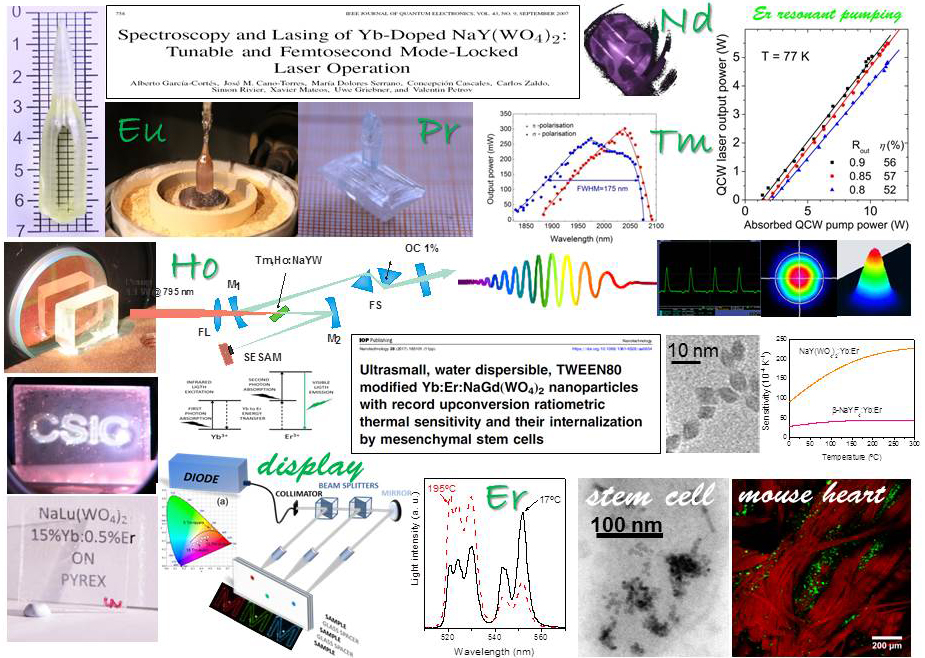


 Our recent publication in Journal of Materials Chemistry A 2023, 11, 19854 (doi 10.1039/d3ta03654e) in collaboration with the Institute of Chemical Technology (UPV-CSIC) in Valencia (among others) adresses the problem found in Tandem Catalysis of having»spatially proximate but thermally distant» catalysts contained in a single reactor. An elegant solution arose through the specific heating of the hot catalyst by magnetic susception. A thermal gradient of 50 ºC between the hot and cold catalysts was infered by luminescence lifetime thermometry by using Eu3+-doped and Cr3+-doped nanoprobes. A probe of concept was demostrated by direct production of propene from ethene, via sequential olefin dimerization and metathesis reactions.
Our recent publication in Journal of Materials Chemistry A 2023, 11, 19854 (doi 10.1039/d3ta03654e) in collaboration with the Institute of Chemical Technology (UPV-CSIC) in Valencia (among others) adresses the problem found in Tandem Catalysis of having»spatially proximate but thermally distant» catalysts contained in a single reactor. An elegant solution arose through the specific heating of the hot catalyst by magnetic susception. A thermal gradient of 50 ºC between the hot and cold catalysts was infered by luminescence lifetime thermometry by using Eu3+-doped and Cr3+-doped nanoprobes. A probe of concept was demostrated by direct production of propene from ethene, via sequential olefin dimerization and metathesis reactions.
